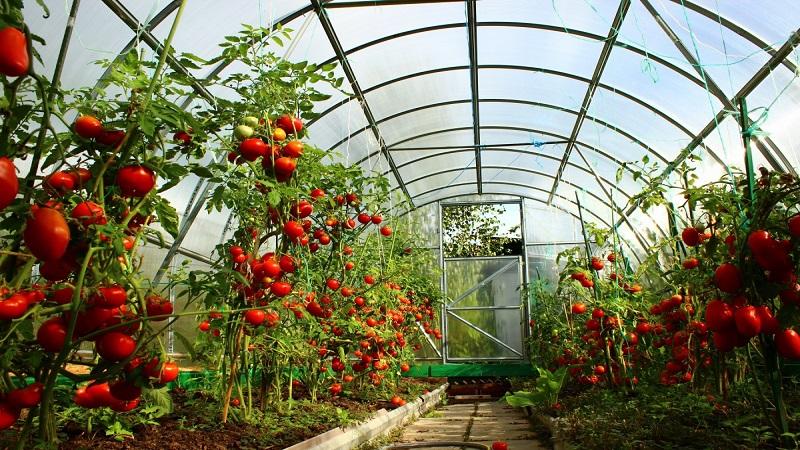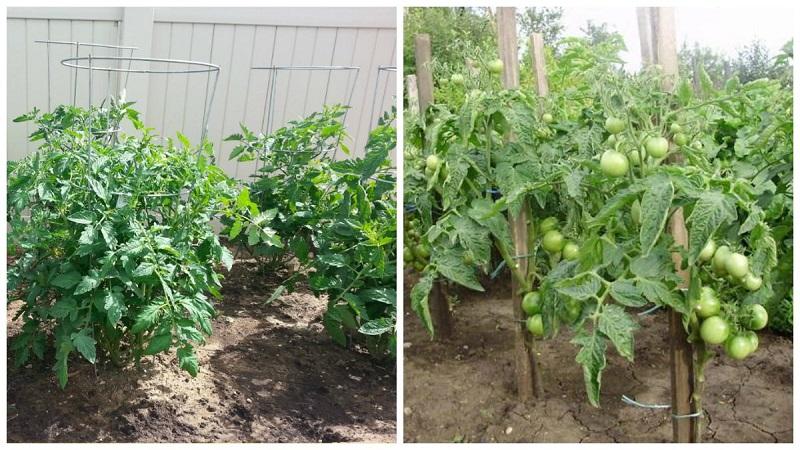What types of tomatoes are there: key differences and features of choice
Many people love tomatoes, including for their relative ease of cultivation. However, summer residents are often faced with the problem of choosing: which variety to plant in order to please themselves with an excellent harvest? In the article you will learn about what types of tomatoes there are, their characteristics and what to look for when choosing a variety to grow.
Features and differences of tomatoes
Tomatoes are among the most common vegetables to grow. They contain a lot of useful elements, in particular lycopene, a powerful antioxidant that reduces the risk of formation and prevents the proliferation of cancer cells.
Tomatoes also contain a large amount of vitamins and microelements necessary for humans: serotonin, phytoncides, chromium. Serotonin is a well-known “happy” hormone that improves mood. Phytoncides are plant substances that inhibit bacterial growth. And chromium promotes rapid saturation, which, by the way, makes tomatoes an excellent product for dietary nutrition.
There is a theory that foods that are similar to a certain part of the body have a positive effect on that organ. So, heart-shaped tomatoes reduce the risk of developing cardiovascular diseases. In addition, they improve digestion and are useful for asthenia, atherosclerosis, and azotemia.
But not all people can eat tomatoes. For example, they are contraindicated for older people suffering from bone and joint diseases.This is due to the fact that frequent consumption of tomatoes leads to the accumulation of calcium and salts in the body. Therefore, excessive consumption of tomatoes is contraindicated for all people. It is recommended to eat no more than 200 g of this vegetable per day.
Important! Pregnant women should not eat more than 100 g of tomatoes in 2-3 days, as consuming more can cause problems in the formation and development of the child.
Another disadvantage is that tomatoes contain a large amount of acids. They can provoke spasm of the gallbladder.
There are several types of tomatoes. Let's look at this issue in more detail.
Determinant
Determinate – varieties whose growth is limited. These tomatoes have many advantages:
- limited upward growth involves the development of strong lateral stepsons that bear fruit, which makes such varieties high-yielding;
- one-time fruiting - determinate tomatoes produce a large harvest that does not stretch over time;
- early fruit ripening;
- adapt well to open ground;
- limited growth spares the gardener from tying up and replacing supports.
But the variety also has some disadvantages:
- limited growth leads to limited yield, that is, the yield is lower than that of indeterminate varieties;
- low resistance to diseases.
The most famous determinate varieties of tomatoes are Sakhalin, Ladies' Man, King of Early and Golden Heart.

Indeterminate
Indeterminate varieties have unlimited growth. They also have certain advantages:
- high yields from a small area of land - due to the high growth of individual plants;
- long fruiting period: in open ground they produce crops until the weather gets cold;
- resistant to most diseases.
But we cannot help but note some disadvantages:
- large growth requires special care: plants must be constantly tied up using high supports, good lighting and air exchange must be provided;
- it is necessary to remove all the stepsons so that the nutrients go to the formation of the main stem;
- They perform well in greenhouses, but in open ground in regions that are not hot enough they ripen quite late and bear less fruit.
Indeterminate tomatoes include such popular varieties as Babushkin Secret, Bull's Heart and Chernomor.

Standard
These are compact plants with one short and thick stem. They do not require specific care: no need to pin or tie them up. They produce a good harvest, but the tomatoes are usually small.
Standard tomatoes include Snow White, Riddle and Moskvich.

Superdeterminant
Superdeterminate tomato varieties are the fastest ripening. They are ideal for those who want to get an early harvest without much effort.
These varieties do not require pinching. Also, due to its short stature, a garter is not needed. The downside is that, after harvesting once, you can’t expect more fruits from super-determinate varieties.
Popular varieties of superdeterminate tomatoes are Children's Sweetness, Alaska and White Bulk.

Semi-determinate tomatoes
Semi-determinate varieties combine the properties of determinate and indeterminate varieties. They have an average height, which allows you to harvest a large harvest from one plant, but without putting in much effort, tying and pinching the bush. In this case, the fruits are formed throughout the growing season.
It is preferable to grow such tomatoes in greenhouses.
The most popular hybrids of this type of tomato are Yvette F1, Gravity F1, Red Arrow F1.

Classification of tomatoes by ripening time
Tomato varieties differ not only in size and method of care, but also in ripening time. There are ultra-early, early-ripening, mid-early, mid-ripening and late-ripening varieties.
Ultra early ripening tomatoes
These tomatoes ripen in approximately 80-85 days from the moment the first shoots appear in seedlings. Most often these are super-determinate varieties. You should not expect large sizes and outstanding taste from these vegetables, since they ripen in short daylight hours and during the cold season.
Ultra-early ripening varieties include Children's Sweetness and Cherry Potok.
Early ripe tomatoes
These tomatoes take a little longer to ripen: in 90-95 days, the field begins to sprout. In addition to super-determinate varieties, these can also be determinate varieties of small and medium growth, as well as standard plants. Some types of early-ripening tomatoes are suitable for open ground, while others are preferably planted in a greenhouse.
Tsar Bell and Sugar Bison are prominent representatives of early ripening tomato varieties.
Read also:
Why do you love tomatoes from the “Peach” series?
The most delicious tomato for lovers of large fruits: the “King of Giants” tomato.
Mid-early tomatoes
These varieties produce a harvest a little later than 3 months after germination - on the 100-103rd day. They can be grown both in a greenhouse and in open ground, preferably in the southern part of the site.
Mid-early tomatoes include, for example, the Moscow delicacy and the giant of the Moscow region.
Mid-season tomatoes
Mid-season tomatoes cannot do without a lot of sunlight and heat, but they can be grown both in greenhouses and in open ground. They ripen 100-115 days after the first shoots.
boyfriend and Budenovka - well-known representatives of this variety.
Late-ripening tomato varieties
Late-ripening varieties are the most demanding in terms of growing conditions. Good yields can only be expected if they are grown in a greenhouse, providing them with the most comfortable conditions. The harvest can be obtained only on day 120-130. But the fruits delight with their size, juiciness and sweet taste.
Bright representatives of late-ripening varieties - Bull's heart, Titan and Finish.
How to choose the right tomato variety
When choosing a particular tomato variety, it is important to answer the following questions:
- In which region will the plants be grown - northern, southern, middle zone?
- Where will the tomatoes be planted - open ground, greenhouse?
- After what period do you want to harvest - early ripening, late?
- What are the purposes of cultivation - for canning, salads, juices or for fresh consumption?
- Is it possible to devote a lot of time to caring for plants - pinching, tying, fertilizing, weeding, shaping, treating diseases, etc.?
- Do size, shape and color matter?
- Does yield matter?
By answering these questions, it will be much easier to choose the variety that is most suitable for you.
Conclusion
A large number of tomato varieties raises a logical question among gardeners: which variety to choose? They differ in size, taste, care rules, yield and many other characteristics.
To select a variety and variety, you should initially read in detail the description of all types of crops and answer questions regarding your goals and capabilities for growing tomatoes. Wishing you ripe and delicious harvests!